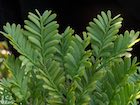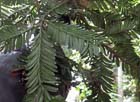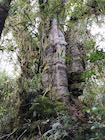Pectinopitys
C.N.Page 2019
Common names
There are no common names for the genus, nor for the genus Prumnopitys from which Pectinopitys was fairly recently segregated. Most of the species also lack common names; being uncommon, they tend to be lumped with other podocarps of similar appearance. Only one species truly has a vernacular name: P. ferruginea, the miro of New Zealand.
Taxonomic notes
A genus of 6 species, all formerly assigned to Prumnopitys until the new genus was described in 2019:
See Prumnopitys for discussion of the rationale for dividing the genus as originally erected into the genera Pectinopitys, Prumnopitys and Sundacarpus.
Description
Trees. Form not described. Bark smooth, breaking into irregular plates, shades of greenish-grey throughout. Twigs dorsiventrally flattened. Foliage buds conspicuous, their scales numerous and tightly-clasping, long remaining apparent after shoot emergence as clusters of usually blunt clasping basal scales. Leaves pectinate on all lateral shoots, petiolate, twisted at the base, close-spaced, the lengths of successive leaves typically similar or evenly graded towards the tips; usually broad, typically curved to falcate, stiff, tapering evenly through their upper third to a usually acute tip, margins typically flat; dorsal surfaces mid- to dark glossy green, under-surfaces broadly banded green to white; basal abscission zones present. Pollen cones borne in simple, open spikes or solitary and separated, each cone relatively long, ascending to erect. Seed cones stalked, variably ovoid-elongate in shape, acutely apiculate, ripening from green to shades of red. Seed not described (Page 2019).
Distribution and Ecology
Australia: Queensland; Bolivia; Colombia; Costa Rica; Ecuador; New Caledonia; New Zealand; Peru; Venezuela. Occurs at lowland to montane elevations in wet subtropical to tropical rainforest (annual rainfall 1.5-4 m) (Farjon 1998, 2010; Hill 1998; de Laubenfels 1972; Salmon 1996). Like Prumnopitys (and Lepidothamnus, Podocarpus, and Retrophyllum), the genus has representatives on both east and west sides of the Pacific Ocean. It thus predates the breakup of Gondwana, which happened in late Cretaceous time when South America separated from Antarctica.
Remarkable Specimens
There are few data, but the widest and tallest tree is probably in Pectinopitys ferruginea or P. harmsiana. With regard to maximum ages, I have only found data for P. ferruginea. The oldest is a ring-counted specimen showing 744 years despite severe ring-wedging.
Ethnobotany
Aboriginal uses are only recorded for P. ferruginea. Pectinopitys harmsiana is a moderately important timber species, and most of the others have been exploited for their timber in the past but are now too rare to be economically significant, or are found in protected areas. The exception is P. ferruginoides, which seems to have no history of exploitation.
As of 2007 there have been seven studies exploring the use of Prumnopitys in dendrochronology, including exploratory analyses and a couple of geological dating studies. In general, the genus suffers from poor circuit uniformity with common false and/or missing rings.
Observations
See the species accounts.
Remarks
Plants of this genus (or of Prumnopitys) have been found in early Miocene (about 20 million years ago) sediments in southern New Zealand (Pole 2007).
Citations
Hill, K. D. 1998. Introduction to the Gymnosperms; Coniferophyta; Cycadophyta; Pinophyta. In A.E. Orchard (ed.), Flora of Australia vol. 48, Ferns, Gymnosperms and Allied Groups. Canberra: CSIRO.
Page, Christopher N. 2019. New and Maintained Genera in the Taxonomic Alliance of Prumnopitys s.l. (Podocarpaceae), and Circumscription of a New Genus: Pectinopitys. New Zealand Journal of Botany 57(3):137–53. https://doi.org/10.1080/0028825X.2019.1625933.
See also
Podocarpaceae and Prumnopitys.





